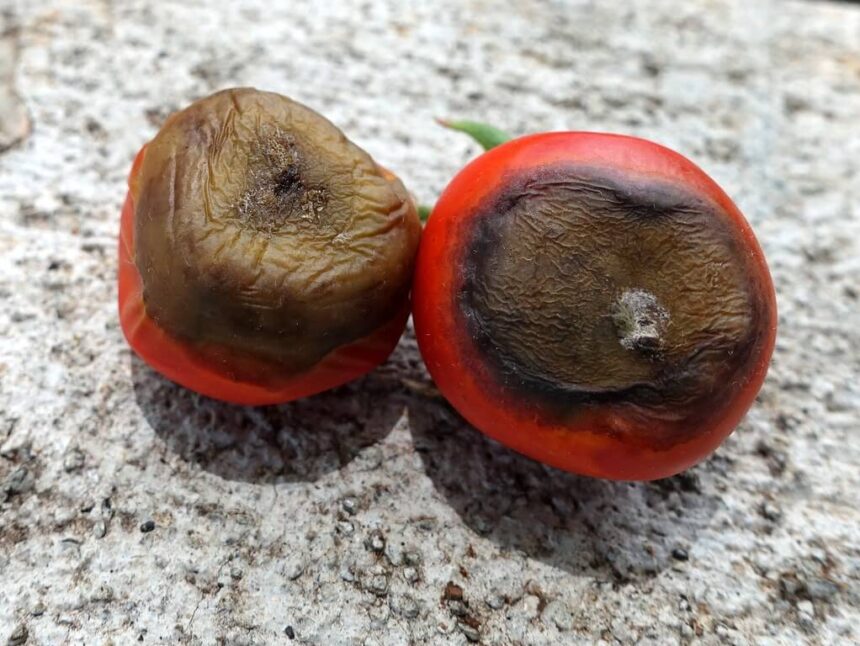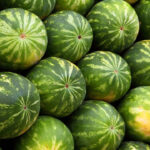Blossom end rot is a common problem for tomato growers in Kenya. It can cause the death of your plants, and it’s essential to know how to treat it if you want to save your crop. In this article, we’ll discuss what causes blossom end rot and give you tips on how to treat it.
Blossom end rot is a common disorder of tomatoes (Lycopersicon esculentum) and other solanaceous crops characterized by a sunken, leathery lesion on the blossom end of the fruit.
Initially water-soaked, the lesion dries out and turns brown or black. Blossom end rot is caused by a lack of calcium in the fruit.
The disorder is most likely to occur when the plant is under stress from drought, excessive heat, or root damage.
See also Pests and Diseases Affecting Avocado Farming in Kenya
What is Blossom End Rot in Tomatoes?
Blossom end rot is a condition that affects tomatoes, peppers, eggplants, and squash. The disease is characterized by a dark brown or black decay that starts at the blossom end of the fruit (the end opposite the stem).
It’s caused by a lack of calcium in the fruit. The symptoms of this disorder are a dark brown or black spot on the bottom of the fruit. The fruit will also become soft and rotten.
What Causes Blossom End Rot?
Several factors can contribute to blossom end rot. One of the most common is a lack of calcium in the soil. Other factors include:
- Poor soil nutrition: If your soil lacks calcium, your plants will not be able to absorb it properly. This can be due to several factors, including poor drainage, low organic matter, or high nitrogen levels.
- High temperatures: Scorching weather can cause the plant to stop absorbing calcium.
- Transplant shock: If your plants are transplanted too early or too late in the season, they may experience transplant shock. This can cause the plant to stop absorbing calcium.
- Inconsistent watering: If you water your plants inconsistently, the roots will not be able to absorb calcium properly. This can cause the fruit to rot.
- Poor root development: If your plants have poor root development, they will not be able to absorb calcium properly. This can be due to several factors, including compacted soil, drought, or excessive fertilizer.
How to Prevent Blossom End Rot in Tomatoes
If you think your plants have this disorder, you can do a few things to prevent or treat it.
- Add calcium to the soil: One of the best ways to treat blossom end rot is to add calcium to the ground. You can do this by adding lime or gypsum to your garden.
- Improve drainage: If your soil is poorly drained, it can cause a lack of calcium in the plant. You can improve drainage by adding organic matter to the ground.
- Water regularly: One of the best ways to prevent blossom end rot is to water your plants consistently. This will help the roots absorb calcium properly.
- Avoid excessive nitrogen: High nitrogen levels in the soil can cause blossom end rot. You can avoid this by using a nitrogen-based fertilizer sparingly.
- Mulch your plants: Mulching can help prevent blossom end rot by keeping the roots cool and moist.
The Importance of Water and Fertilizer for Plant Health
Water and fertilizer are two of the most important things you can give your plants. Water helps the roots absorb nutrients, and fertilizer provides the plant nutrients to grow.
If you think your plants have this disorder, it’s essential to water them regularly and fertilize them properly.
This will help prevent the disorder from spreading and help your plants recover from the damage.
In addition to proper watering and fertilization, there are several other things you can do to prevent this disorder from occurring in your garden plants:
- Avoid excessive pruning: Excessive pruning can cause this disorder by damaging the plant’s roots.
- Don’t overcrowd your plants: Overcrowding can prevent the roots from getting the air and water.
- Plant in well-drained soil: Poor drainage can cause a lack of calcium in the ground.
- Avoid mechanical damage: Mechanical damage to the roots can prevent the plant from absorbing calcium properly.
- Use mulch: Mulching your plants can help prevent blossom-end rot by keeping the roots cool and moist.
You can prevent this disorder from occurring in your garden plants with proper care. By following these tips, you can ensure that your plants have the best chance of growing healthy and strong.
Tomato Varieties are affected mainly by this disorder.
Among the different varieties of tomatoes, some are most affected by blossom end rot. One such type includes the traditional array. They typically elongated one.
The Oxly variety is also more prone to this disease than small-sized tomatoes. On the other hand, the smooth medium-large round and hybrid varieties tend to be less affected.
Basic Fertilization
During the initial field preparation and planting, proper fertilizer application is essential. It is also vital to apply ripe compost manure.
Furthermore, crop rotations are encouraged, mainly if the same problem has occurred in previous years; the soil is probably low in calcium.
You can also make up for calcium deficiency in the soil by applying foliar fertilizers such as FERRARI GOLD from Green Life Africa or Easygro from Osho Chemicals ltd.







